71% of employees in a Capterra survey say they’re overwhelmed by the amount of change at their job. They’re placing the blame on employers.
From staying on top of the latest COVID protocols to employers going back-and-forth on their hybrid work plans, employees have had to deal with a lot of change at work over the past two years. Now, all that change is taking its toll.
In a new Capterra survey of almost 1,000 U.S. employees[*], 71% say they are overwhelmed by the amount of change that has happened at their job during the COVID-19 pandemic (6% experienced no change at all). Furthermore, 83% of workers suffering from change fatigue say their employer has not provided enough tools or resources to help them adapt.
For a workforce that’s already experiencing record levels of burnout[1], change fatigue threatens to pour salt in an already-gaping wound—further lowering employee productivity, engagement, and retention.
Being agile and embracing change has been vital for business survival over the past two years (and will continue to be important moving forward), but unless HR leaders implement better change management strategies and techniques, their organization’s best workers are likely to walk out the door.
In this report, we’ll look at our survey results to understand who is most affected by change fatigue, where employers are dropping the ball on change management, and why this era of constant change isn’t going anywhere when the pandemic is over.
Key findings
Change fatigue is rampant: 71% of employees—including 86% of those ages 16 to 24—say they are overwhelmed by the amount of change at work. As a result, more than half (54%) of change-fatigued employees are considering looking for a new job.
Employer flip-flopping is causing frustration: 93% of employees suffering from change fatigue say their employer has backtracked on at least one change that was implemented during the pandemic.
Companies could be doing more to help employees adapt to change: 83% of employees suffering from change fatigue say their employer has not provided enough tools or resources to help them adapt to changes at work.
Constant change isn’t just a COVID trend: 78% of employees expect constant change to happen at their job moving forward.
Change at work has been nonstop, and employees are feeling the strain
In October 2020, Gartner issued a warning to HR leaders: "Amid worries about the economy, job security, their health, and the health of their loved ones, employees’ capacity to take on change in the workplace has plunged significantly."[2]
Their conclusion was that the amount of change that the average employee could absorb without becoming fatigued had been cut in half compared to before the pandemic. Employers needed to be extremely careful about implementing changes moving forward.
Nearly two years later, our data shows employers didn't take this warning to heart. Needing to react quickly to volatile market conditions and safety requirements, employers dumped change on employees at an unmitigated pace to the point that 78% of employees in our survey say they’ve experienced more change at their job during the COVID-19 pandemic than at any other point in their career.
Added job responsibilities, having to learn new technology, transitioning to working from home—employees have had to shoulder these major changes, and then some. As a result, change fatigue is widespread: Nearly three out of every four employees (71%) say they are overwhelmed by the amount of change that has taken place at their job.
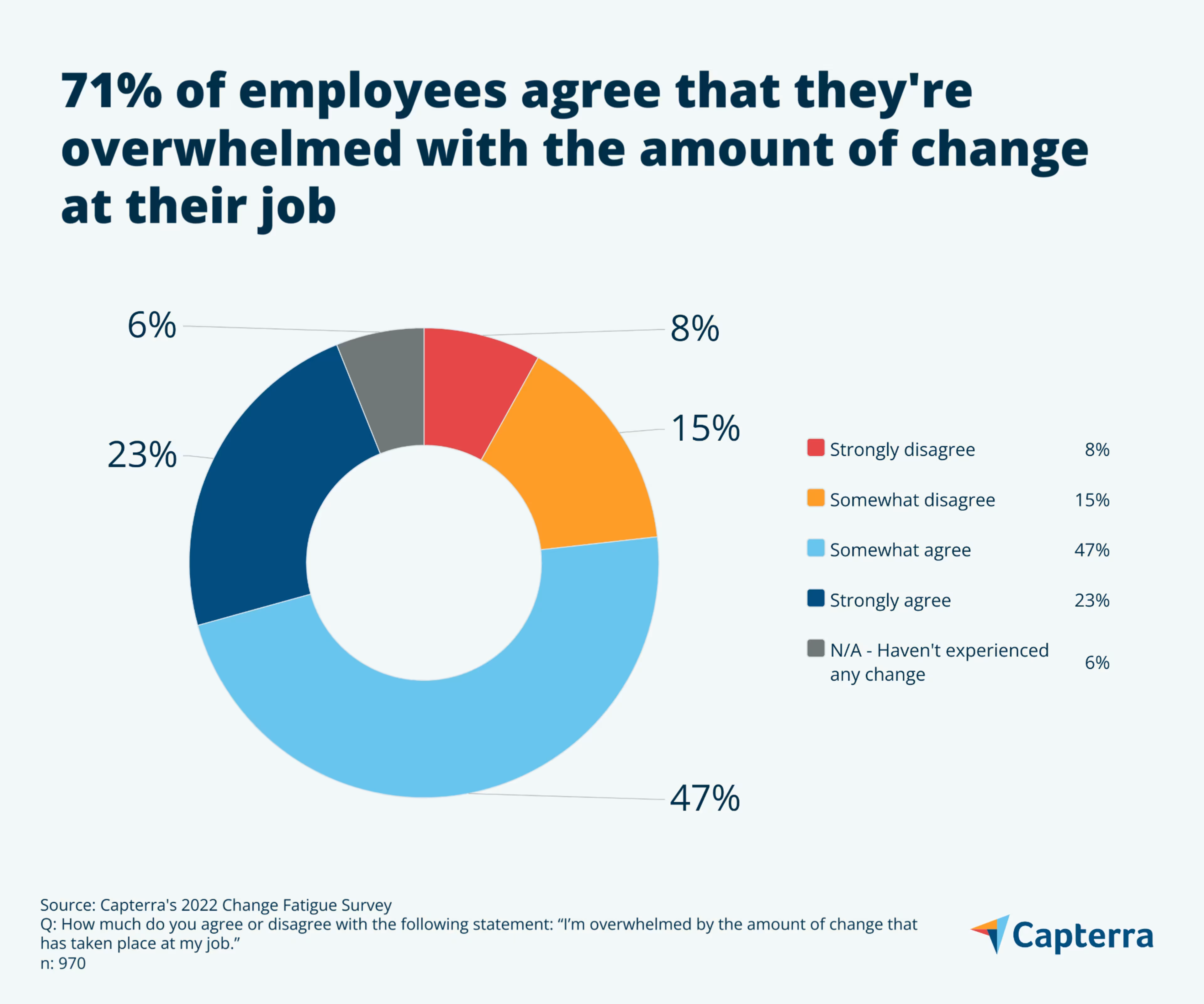
Our data shows that change fatigue has had a deeper impact on some workers over others:
Very young and very old workers: Of those who’ve dealt with change at work during the pandemic, 86% of workers ages 16 to 24 and workers ages 65 and older are experiencing change fatigue.
Women: Of those who’ve dealt with change at work during the pandemic, 79% of women are experiencing change fatigue (versus 70% of men).
Employees at midsize businesses: Of those who’ve dealt with change at work during the pandemic, 80% of workers at organizations with 101-1,000 employees are experiencing change fatigue (versus 73% at organizations with 100 or fewer employees and 68% at organizations with more than 1,000 employees).
Here’s why businesses need to pay attention. When asked how change fatigue was affecting them, 32% of change-fatigued employees in our survey said they’re less productive, and close to half (48%) said they’re more tired or stressed at work. But the most alarming finding of all is that a majority of change-fatigued employees (54%) are considering looking for a new job.
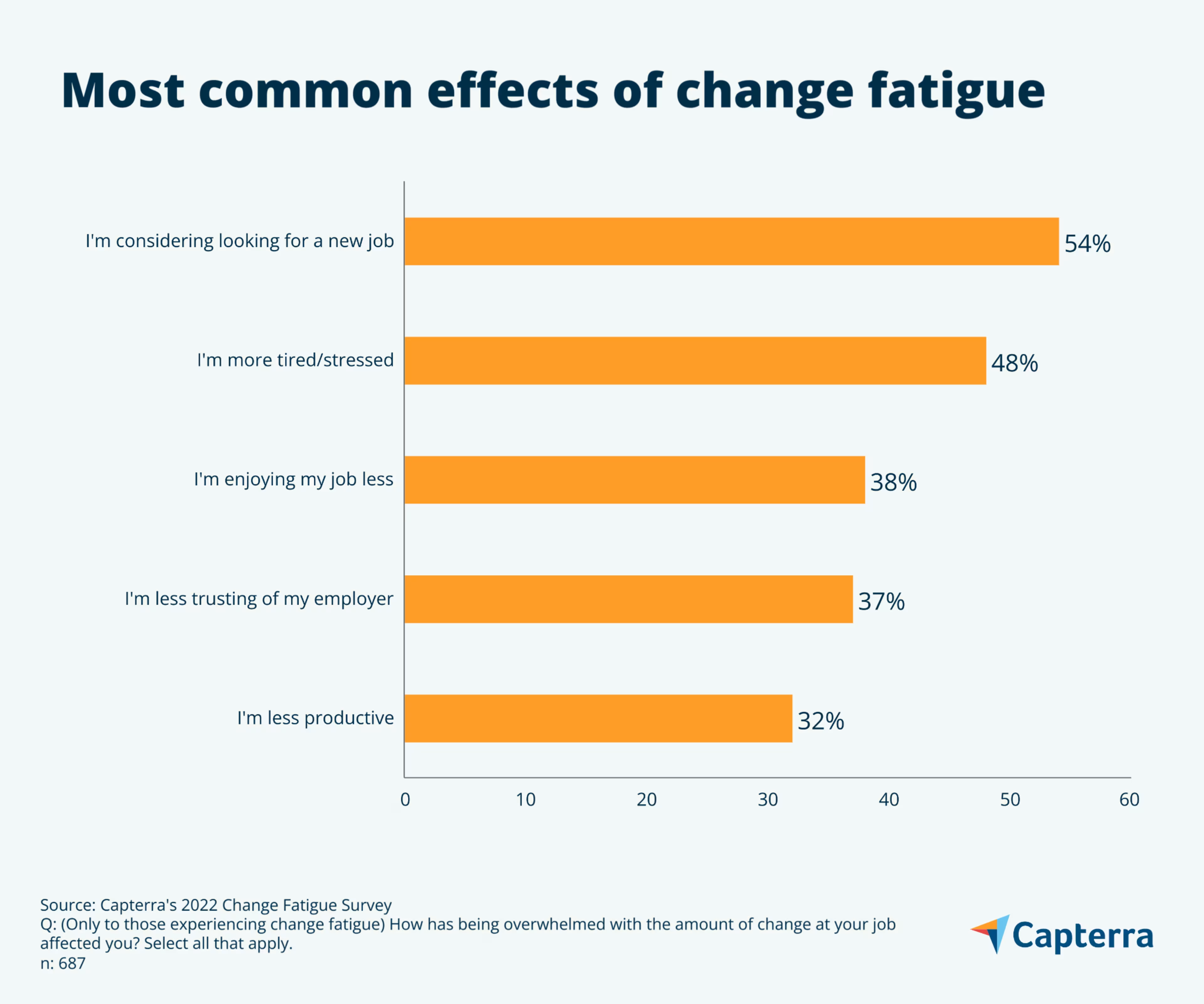
The bottom line is change fatigue has fully set in for U.S. employees, and it’s damaging talent engagement and retention. Unless HR leaders quickly implement change management best practices, rapid employee turnover will make a historically tight hiring market[3] even worse.
Employees blame change fatigue on poor communication, backtracking
While it’s easy to point the finger at COVID-19 for causing major disruptions that have led to so much change at work, the employees in our survey aren’t ready to let employers off the hook for their change fatigue.
For starters, employees say communication around changes at work hasn’t been ideal:
A third of employees in our survey who experienced change at work during the pandemic rate their employer’s communication regarding those changes as either “fair” or “poor” (instead of “good” or “excellent”).
More than one in four (27%) also say their employer has rarely or never asked for feedback or input on changes that have been implemented.
But workers say the biggest sin by far has been employers changing their mind. When asked if their employer had backtracked on any changes made during the COVID-19 pandemic, 93% of change-fatigued employees say they have, with 42% saying it has happened multiple times.
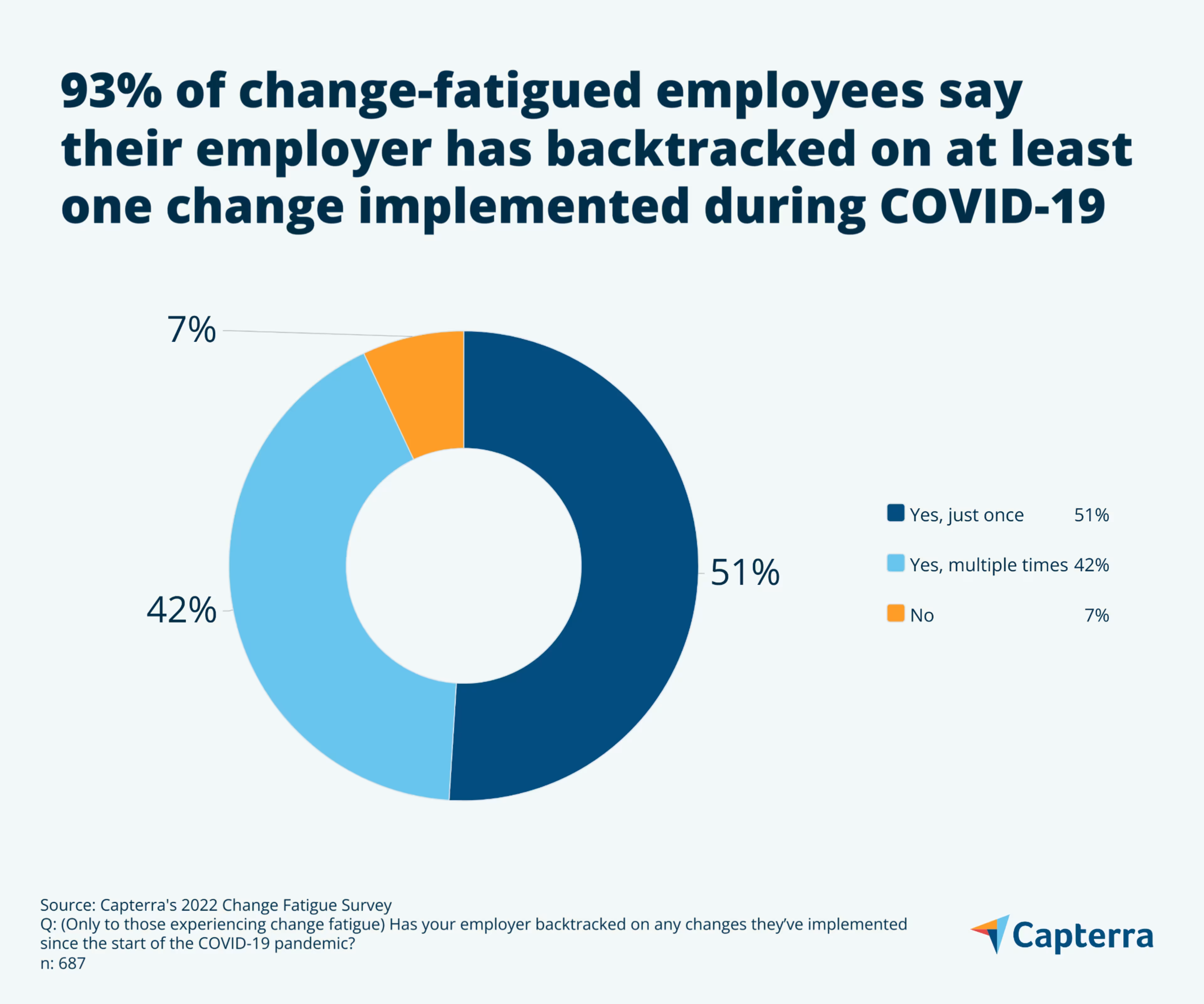
Too much backtracking can decrease employee trust that company leaders know what they’re doing, and leave workers struggling to maintain a sense of normalcy on shaky ground. Look no further than the fight over hybrid and remote work. After the Delta variant of COVID-19 was deemed under control in November 2021, companies began cementing their return-to-office plans and communicating them to remote employees. The Omicron variant arrived soon after, forcing companies to put those plans on hold[4].
The initial Omicron wave faded too, and companies once again resumed their plans to reopen offices. But this time, employers and employees weren't in sync on expectations: In a survey on hybrid work expectations[**], 69% of small-business decision-makers told us they expected employees to be onsite three or more days a week when the pandemic ended. 76% of small-business employees, on the other hand, said they’d prefer to be onsite three or fewer days a week. A backlash has ensued, and now many companies are relaxing or outright rolling back their return-to-office plans[5] to meet worker demands.
At a time when people are more prepared to quit their job[6] than ever before, too many tone-deaf and hastily retracted decisions like this one can be the death of a business by a thousand cuts. Instead of expecting employees to simply deal with change as it happens, HR leaders need to implement better strategies to make change more palatable. In the next section, we’ll show you how.
Workers need help to better adapt to change—here’s what you should do
Employers have been quick to hoist changes on their employees throughout the pandemic, but have been more hesitant to actually help employees adapt to change more easily. Of the employees in our survey suffering from change fatigue, 83% say their employer has not provided enough tools or resources to help them adapt to changes at work.
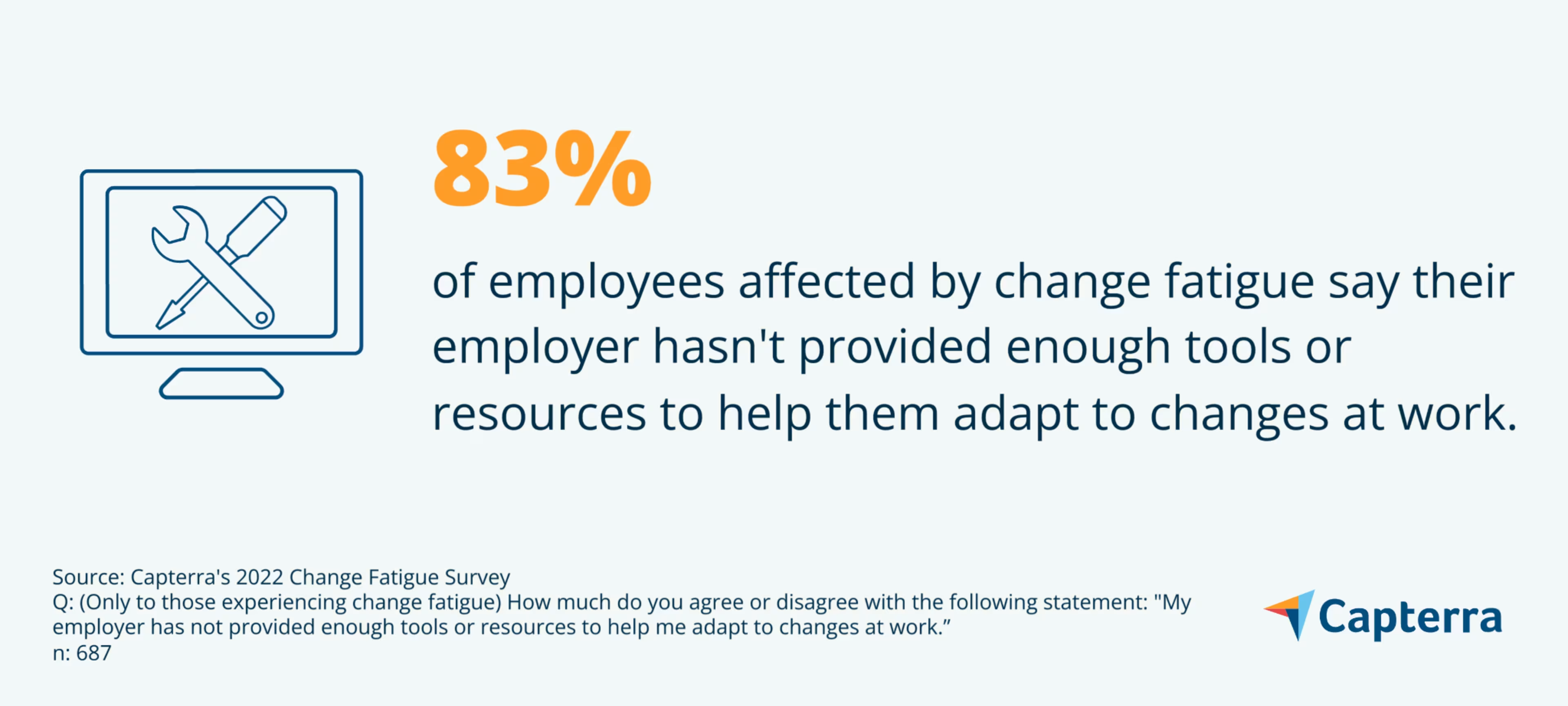
Properly managing change is as much a skill as it is an attitude, and HR plays a pivotal role in developing that skill throughout an organization. With help from Gartner research, here are three change management best practices that HR leaders can implement to give employees more resources and help reduce change fatigue.
1. Customize your approach to change management coaching
Gartner points out that business leaders “often underestimate how important change management is and do not understand why it’s worth their time”[7]. HR is best-suited to coach business leaders on how to be effective change managers, but a one-size-fits-all approach won’t suffice.
Changes vary greatly in their impact and complexity, and some business leaders will have more aptitude for change management than others.
A customized approach to change manager coaching is best, and it starts with HR leaders assessing every business leader’s talent for change management. Doing a skills gap analysis and plotting each business leader on a change management maturity roadmap will give you an idea of who needs the most support when major changes occur.
Then, as changes happen, you can customize your department’s involvement based on the skills of the business leaders involved, and the impact and complexity of the change:
For changes with low impact and complexity, a hands-off approach involving pre-made training resources and holding office hours to answer any questions that come up will suffice.
For changes with medium impact and complexity, HR should act as a “change coach” to provide tailored guidance on specific aspects of change management (such as how to solicit employee feedback on changes).
For changes with high impact and complexity, HR should act as a “change driver” to provide end-to-end, hands-on support throughout the implementation of the change.
Taking this tailored approach allows you to provide the exact right amount of support and coaching that the situation demands.
2. Identify and involve “change advocates” when making big decisions
Business leaders often take one of two extreme approaches when involving employees in making organizational change decisions: Either they don’t involve them at all and only solicit feedback after the fact, or involve everyone in order to reach a true consensus. Gartner says both approaches are flawed[7].
Instead, organizations should find and involve a small but diverse set of employees to act as “change advocates.” These employees should be effective communicators, have functional expertise and clout on their respective teams, and be willing to offer change coaching and support.
Once you’ve identified your advocates, involve them early on in any major changes to provide input. This way, employees still have someone that represents their interests to shape company decisions. Then, once decisions are made and changes are announced, your change advocates (who now have more insight into how and why changes are being made from being involved early on) can be the ones to address any concerns that workers have.
3. Provide scalable support and rewards for the small stuff
It’s a natural tendency to focus on the big changes affecting employees, but it’s really the small changes that add up over time and lead to fatigue. Gartner found that big changes account for just four percent of all changes employees experience at work[8]. The remaining 96% are much smaller in scale—a team member departure, for example, or a new expense reporting requirement.
Asking managers to provide personalized support for every small change that happens in their department is an impossible task. Instead, you should put systems and policies in place that persuade employees to better embrace small changes on their own.
Gartner offers a few examples of what this might look like:
Use skills inventories, scrum boards or other tools that allow employees to see which team members have available bandwidth to learn best practices for small changes.
Empower teams to move work between members if some are more receptive or knowledgeable about a certain change than others.
Recognize and reward employees who go the extra mile to create training resources around small changes or help others keep up with small changes.
Peer recognition systems are ideal for this last one. Employees can share praise for each other on a social media-esque feed for the rest of the department—or even the whole company—to see. Managers can then fold that praise into performance reviews.
Constant change is the new normal, so ensure employees are ready
It would be easy to dismiss everything we’ve covered here as old news. As of writing, the spread of COVID-19 has significantly diminished and, although new waves of the disease are still expected in the future, many organizations are back to business as usual. Yes, all those changes were stressful, but surely employees won’t have to put up with as much change moving forward?
Except in the 2020s, change is going to be everywhere. Businesses are constantly assessing new technology and implementing radical digital transformation initiatives to meet evolving customer and employee expectations. Old ways of doing business are being challenged, and new roles we can’t even imagine will be in high demand: By 2025, it’s predicted 97 million new roles[9] will emerge that are more adapted to the new division of labor between humans, machines, and algorithms.
Employees are as aware of this fact as anyone. In fact, 78% of employees in our survey expect constant change to happen at their job moving forward.
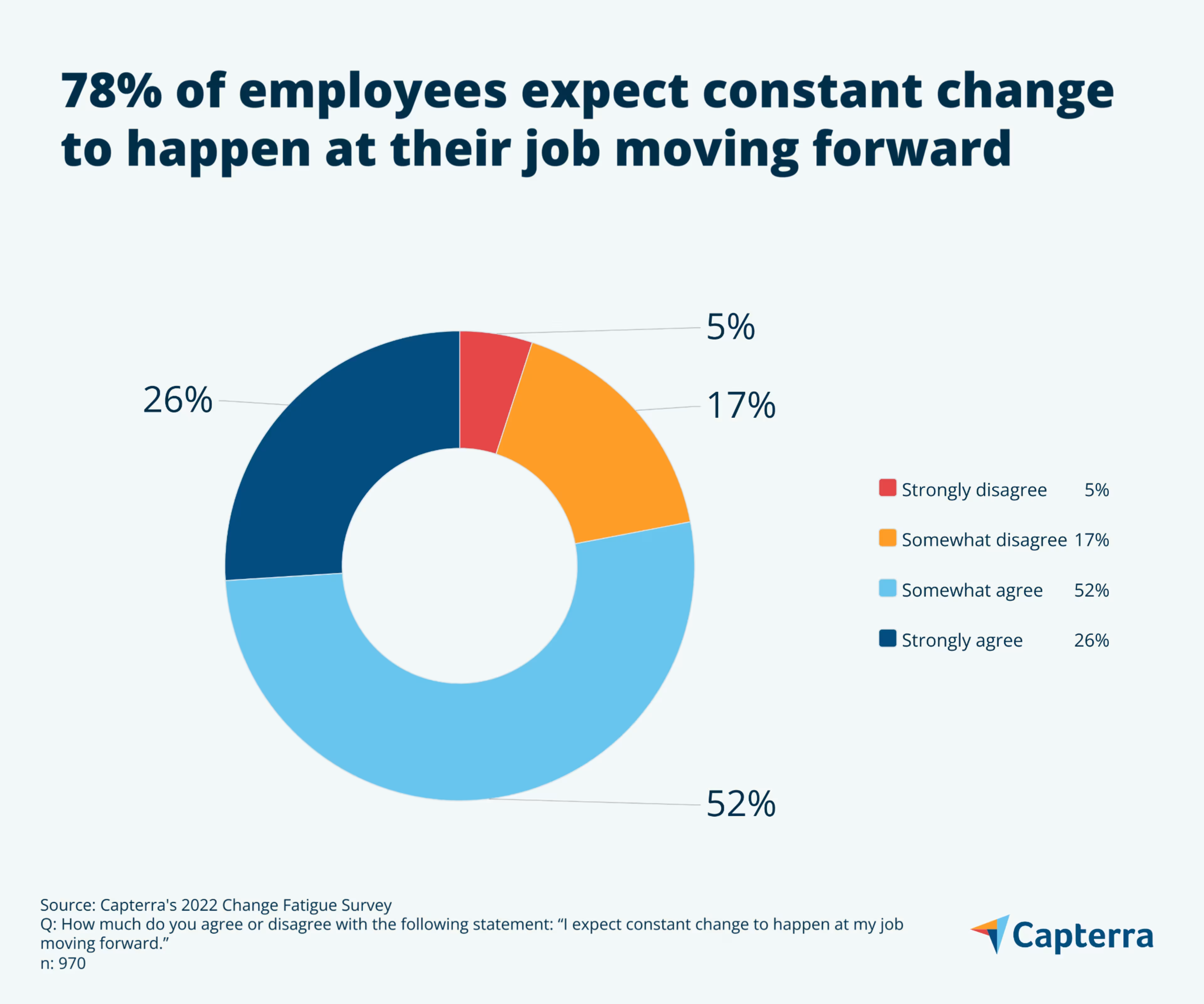
Effective change management will be extremely important as businesses adapt to the future of work. Don’t wait and assume change fatigue will go away. If anything, it’s just getting started.
If you liked this report, check out these other talent management resources:
